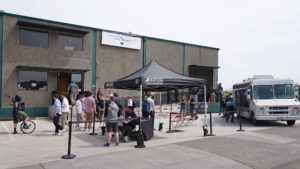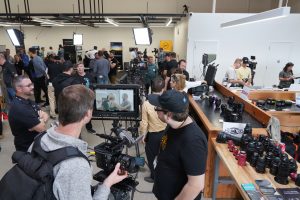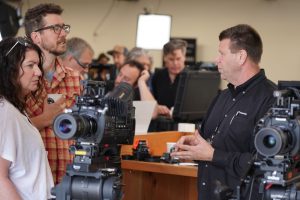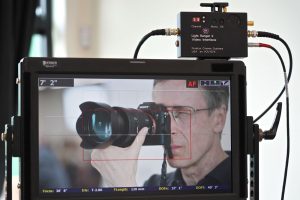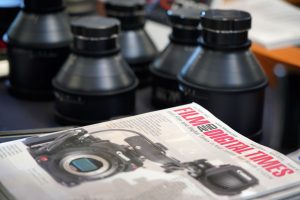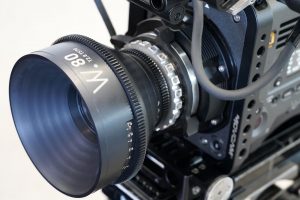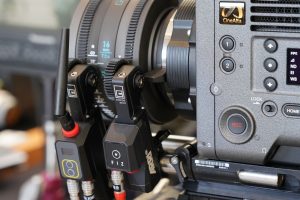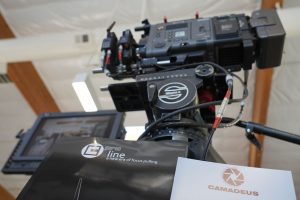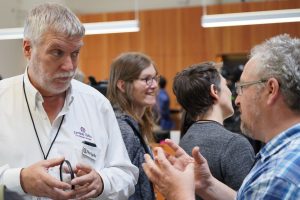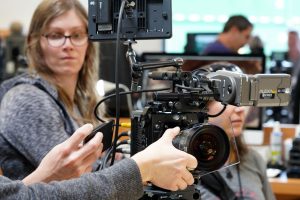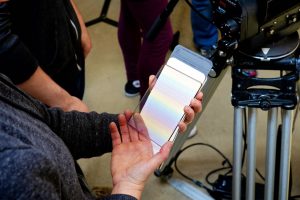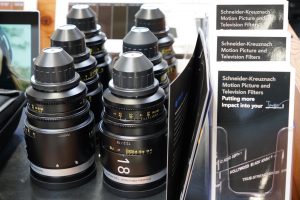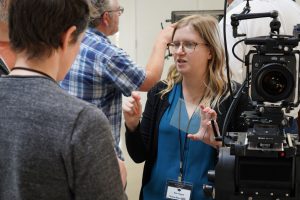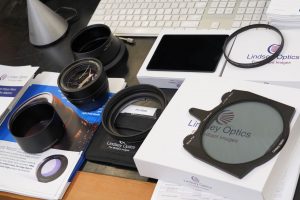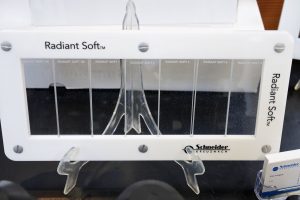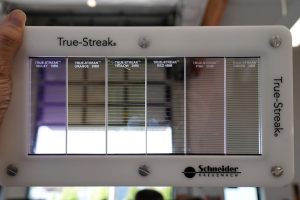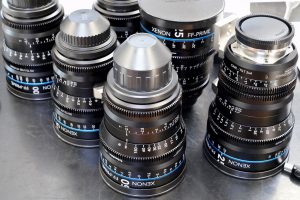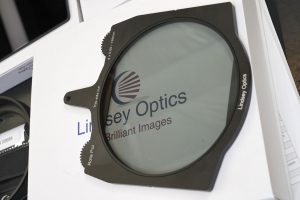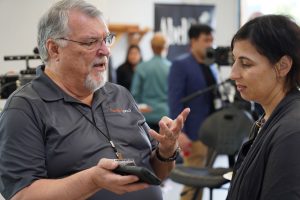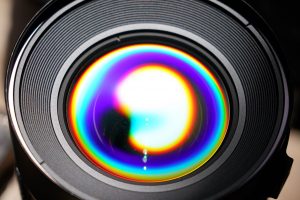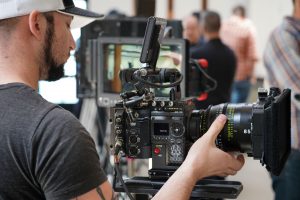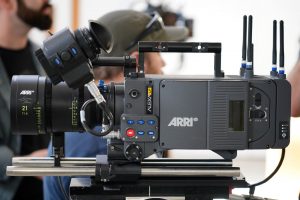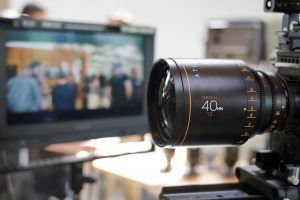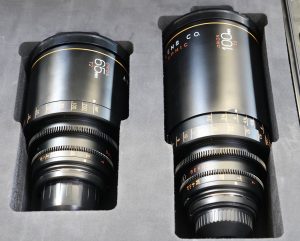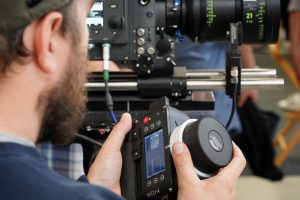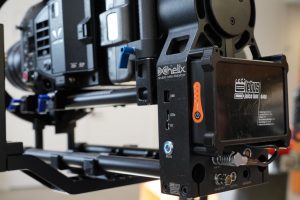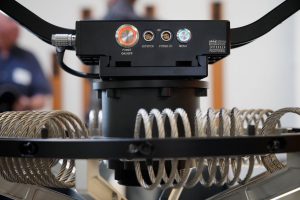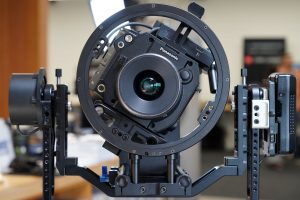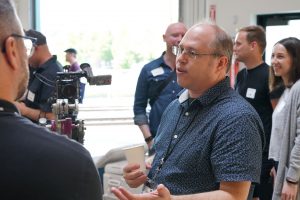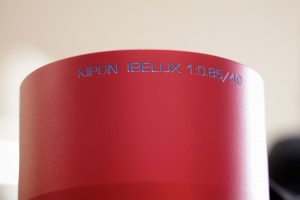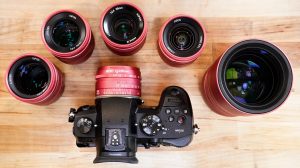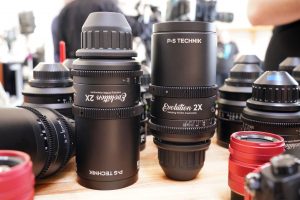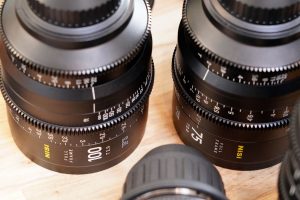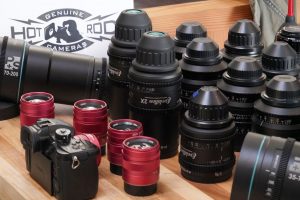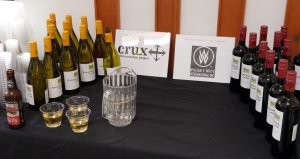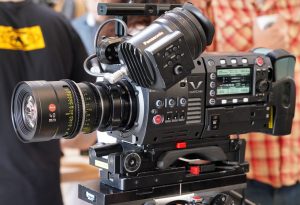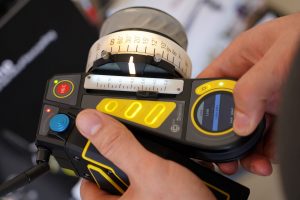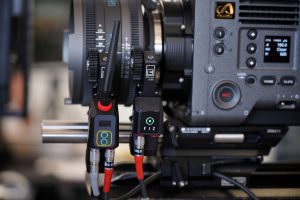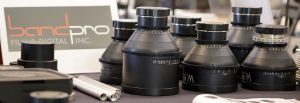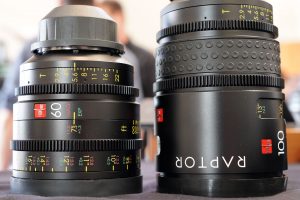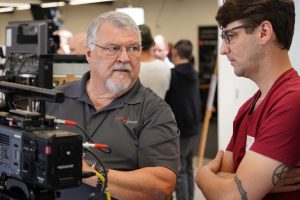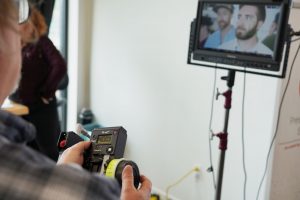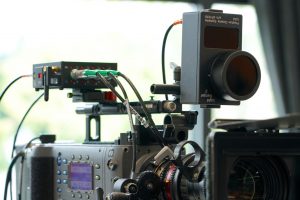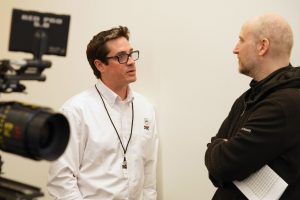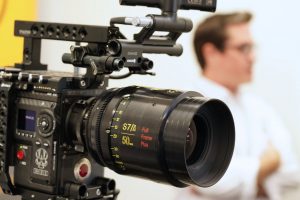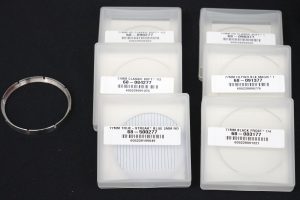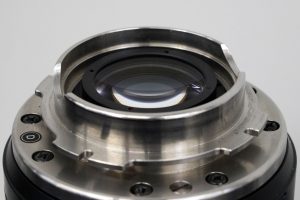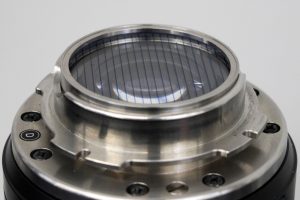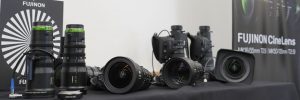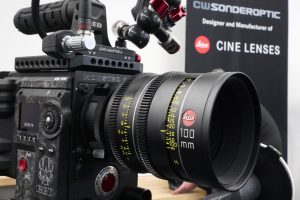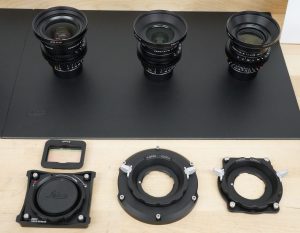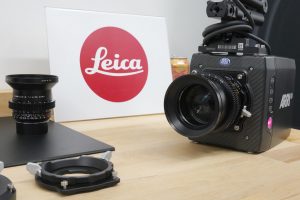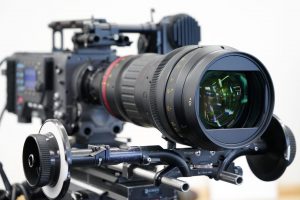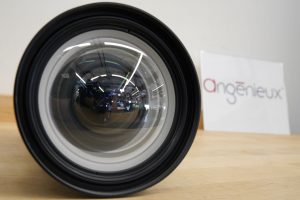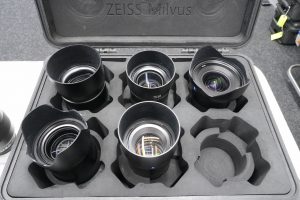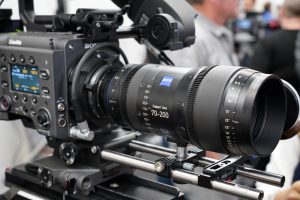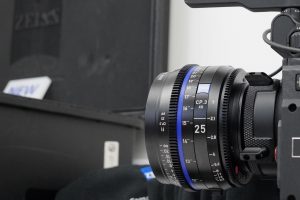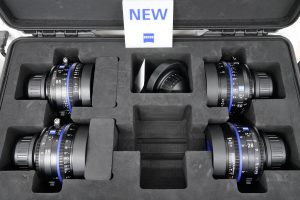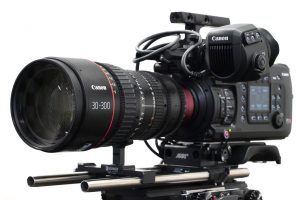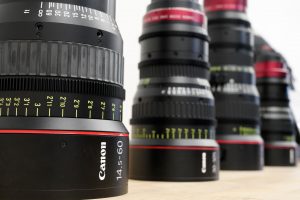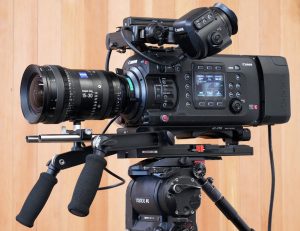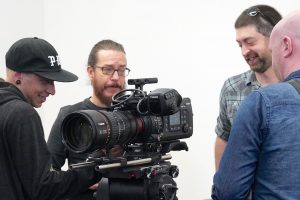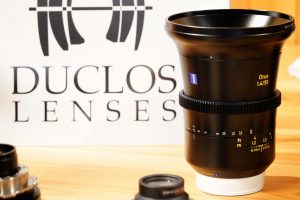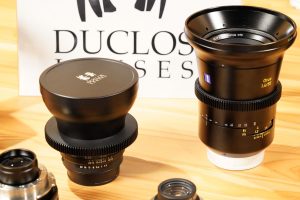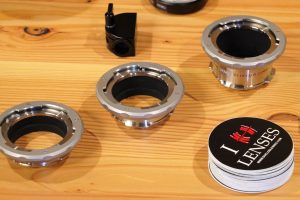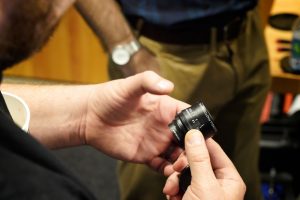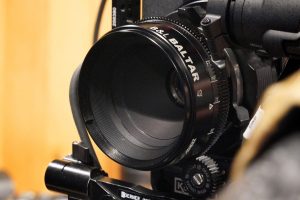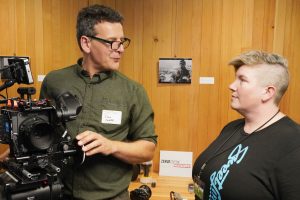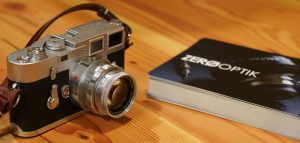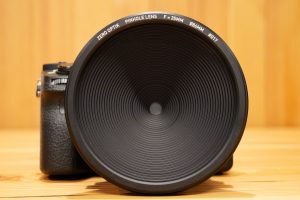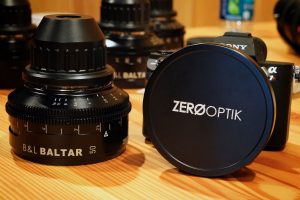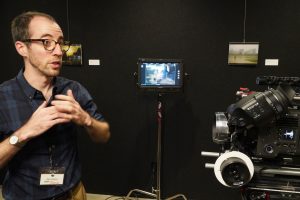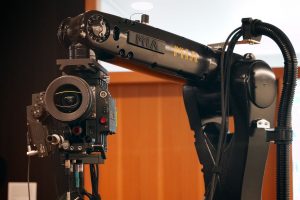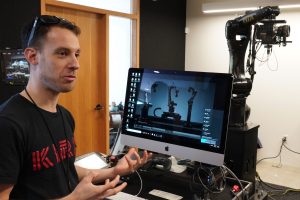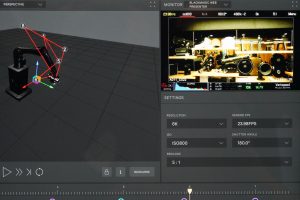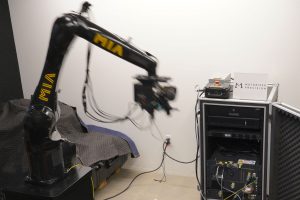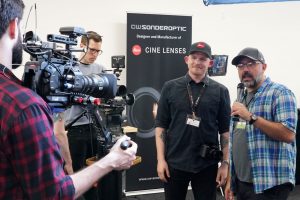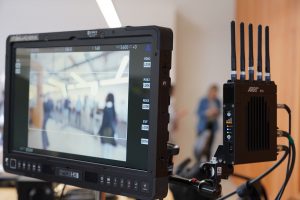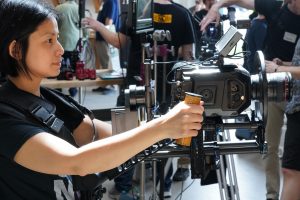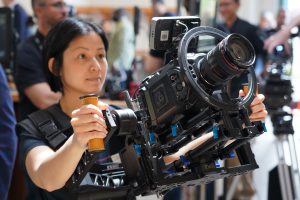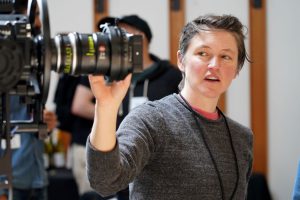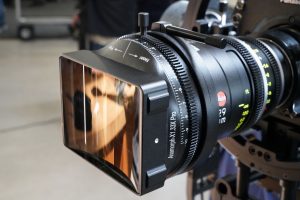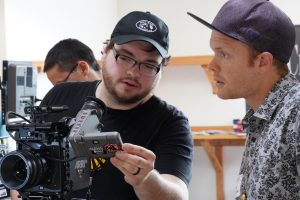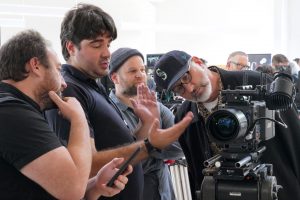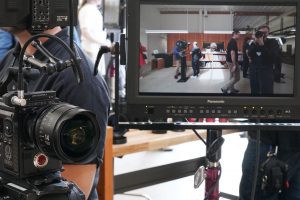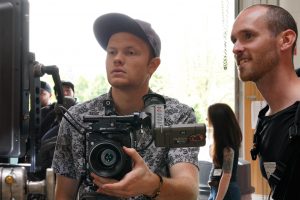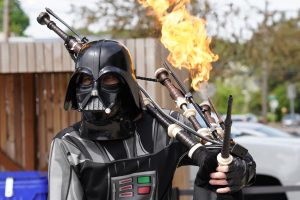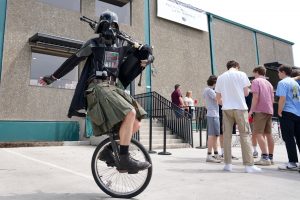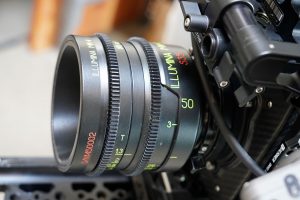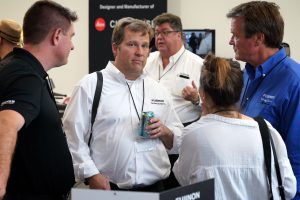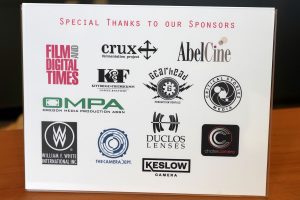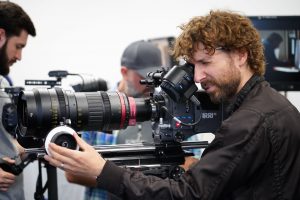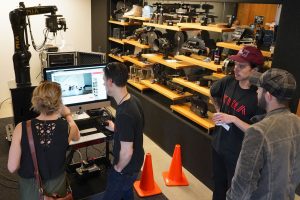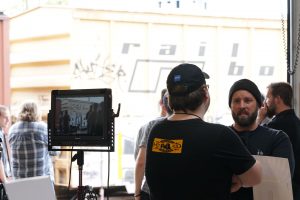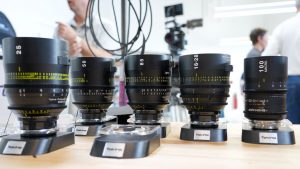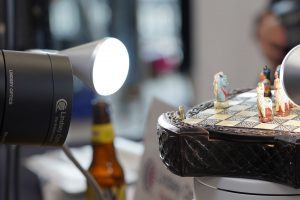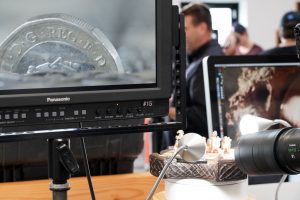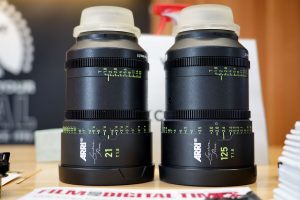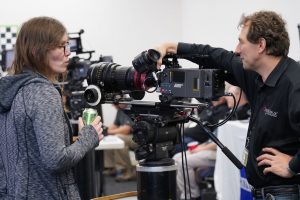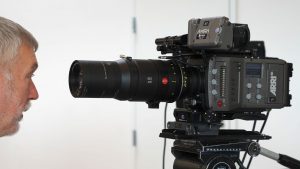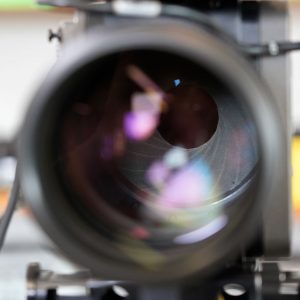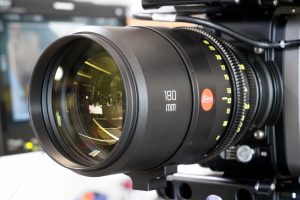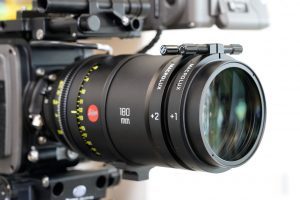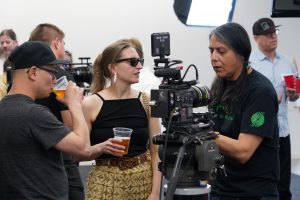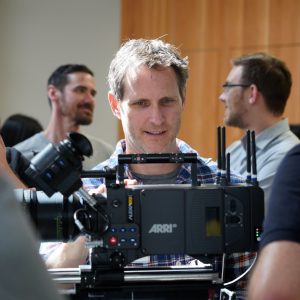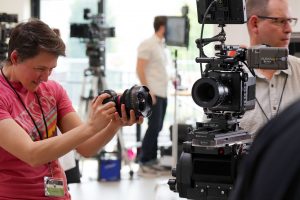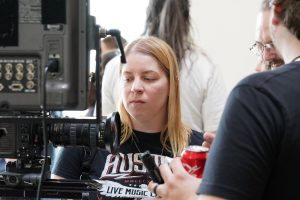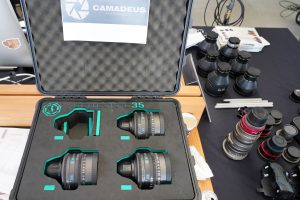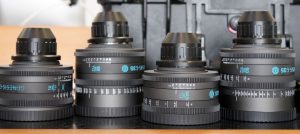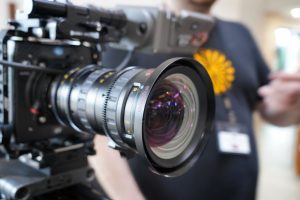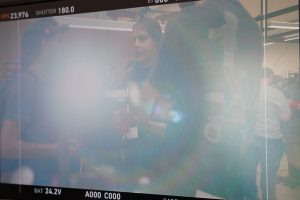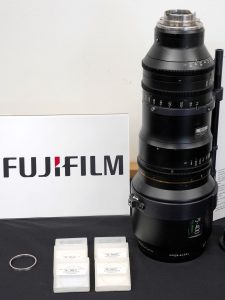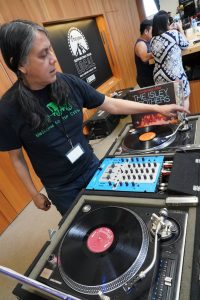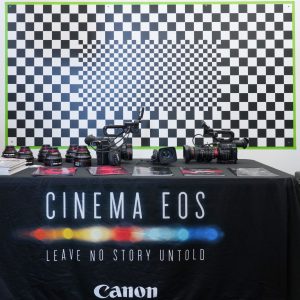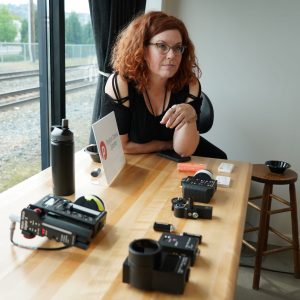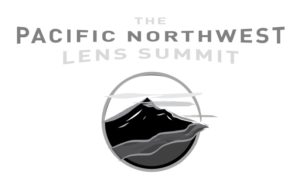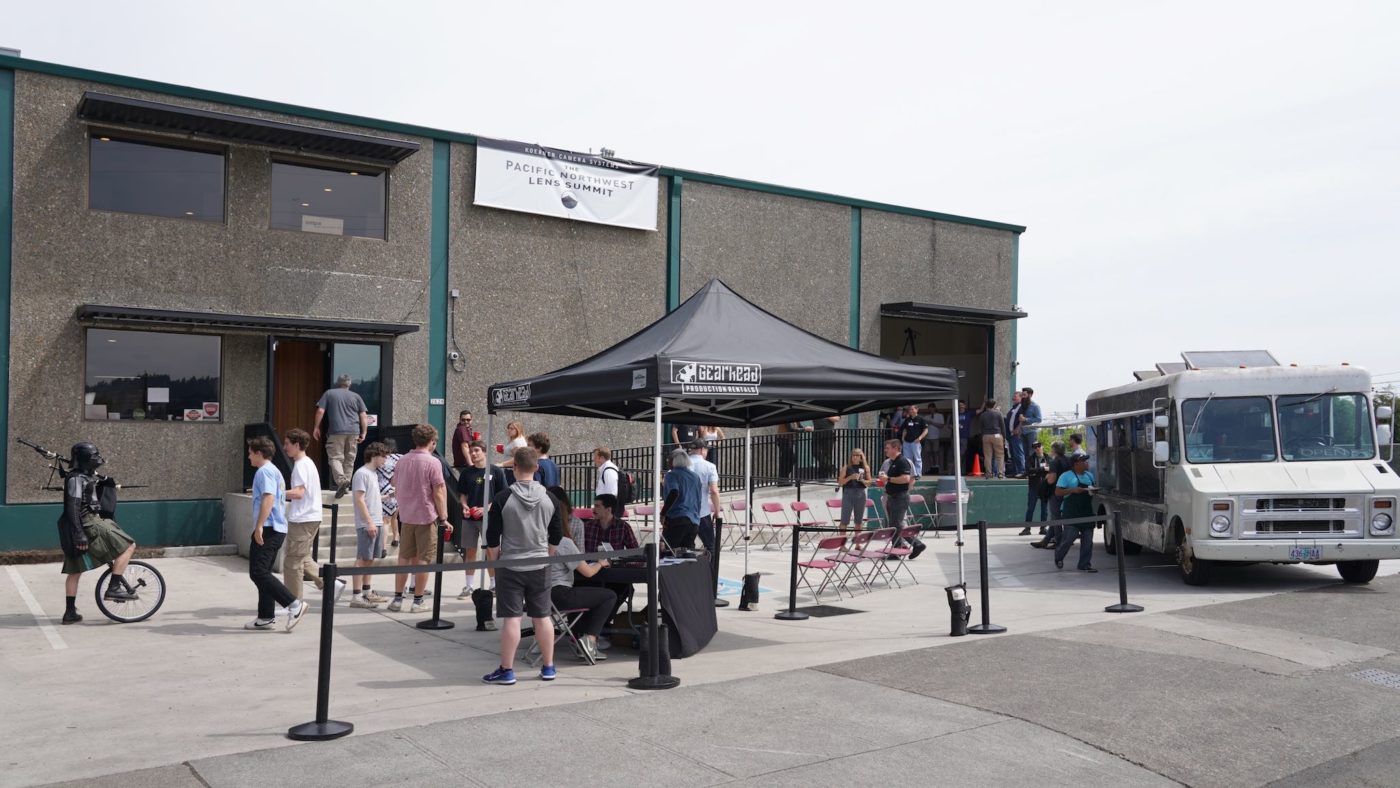
by Adam Wilt
Koerner Camera Systems in Portland, Oregon hosted the 2nd annual Pacific Northwest Lens Summit on the first Saturday in May. About 250 people came to see lenses, filters, FIZ controllers and focusing aids, anamorphics and adapters, gimbals, cameras, and camera robots presented by thirty different exhibitors.
Attendance might have been even higher had Portland not suffered from a warm and sunny day (rain-sodden Portlanders will cheerfully cancel their own weddings for a chance to frolic in the sun). Those who resisted the call of the wild were rewarded with a taco truck, local wine and beer, and — because it’s Portland — exotic donuts. Also — because it’s Portland — the Unipiper: a unicycling, bagpipe-playing, flame-throwing, kilt-wearing Darth Vader. “This machine keeps Portland weird!” is emblazoned on his bagpipes, and no one could possibly disagree.
Attendees enjoyed a wide range of technological treats, including:
Atlas Orion anamorphic primes, crisp and clean and (reasonably) affordable.
Whitepoint Optics cine primes. Finnish lenses re-built from Hasselblad elements, and capable of covering an 82mm image circle.
ARRI Signature Prime large-format lenses, and an Alexa LF to put them on.
Schneider filters including the Rainbow Streak, a sort of technicolor-anamorphic-flare inducer.
Lindsey Optics filters and macro lenses. Lindsey’s Brilliant Macro lenses let you get absurdly close to tiny things yet show no noticeable image defects.
GECKO-CAM GENESIS G35 cine lenses. German-built with circular irises and your choice of coated or uncoated front elements for a “classic modern vintage look.” 43.6mm image circle; PL, LPL, EF, E, F, and MFT mounts.
Hot Rod Cameras reworked an Angenieux DP-series zoom: front element stripped of antireflection edge paint and coatings, then recoated with an “inefficient” multicoating designed to cause colored flare. Angenieux has a similar version, only without the recoating: plenty of flare, no added color.
Tokina Vista large-format lenses: T1.5, sharp, no noticeable chromatic aberration, and uncannily minimal breathing. PL, EF, E, and MFT mounts. These aren’t rehoused stills lenses, they’re all-new, affordable, purpose-built cine lenses.
HandeVision IBERIT and IBELUX lenses from China’s Kipon. The IBERITs are f/2.4, the IBELUX 40mm is f/0.85, and all are available in pink (or silver or black). Leica M and L, Sony E, and Fujifilm X mounts.
A Fujinon 75-400mm cine zoom with a behind-the-lens filter holder, and a set of diffusion and streak filters ready to install.
Leica M0.8 cine lenses: classic M-mount lenses with focus and iris gears. Positive-locking M-mount fronts for Sony VENICE, ARRI Alexa Mini and RED DSMC cameras (the latter two with custom OLPF frame cut away for the lens’s rear element) let large cameras use these compact lenses.
Rehoused classic B&L Baltars and Nikon stills lenses from ZERØ OPTIC, along with a 35mm pinhole lens.
Letus Helix Pro, a 3-axis gimbal for 9 kg / 20-pound cameras. The Helix Pro can be hand-flown with an EXO17 support vest or hard-mounted on a wire rope isolator base. Letus also showed off their 1.33x anamorphic adapter.
Motorized Precision’s MIA camera robot. MIA can fly a 10 kg / 22-pound camera around the room at up the three meters per second, with full FIZ (focus/iris/zoom) control and precise repeatability, all while running off single-phase wall power.
Preston’s Light Ranger 2 focus assist system, a 1st AC’s best friend. Light Ranger 2 graphically illustrates focus distances and depth of field onscreen, vastly reducing a focus-puller’s uncertainty. It can even be used for no-excuses autofocus.
More tools too numerous to describe in detail: FIZ hand units and lens motors from ARRI, Preston, and cmotion. Lenses and adapters from Zeiss, Cooke, Canon, Leica, LOMO, Duclos, Fujinon, Angenieux, P+S Technik, NiSi, Sigma, and Schneider. Sony VENICE cameras, RED MONSTROs, Panasonic VariCams, and Canon C700 FFs. I’m sure I’ve missed some things, at that.
If I had to pick themes or trends for the Lens Summit, I’d pick these: the move to large formats, the ongoing interest in anamorphics, and the desire for “character.” “Character” might explain the number of new lenses available with uncoated front elements, the quest for the roundest iris and the best bokeh, and the number of rehoused vintage lenses and new designs using classic formulas.
Koerner also staged a day-long training session with Duclos and Fujinon on the Friday before the Summit. The invitation-only training drew lens techs from rental houses across the country to witness the complete teardown and re-assembly of a ZEISS Super Speed in the morning and a Fujinon Cabrio in the afternoon.
Lens Summit organizer Michael Koerner said, “Most people said they got more info out of this show than NAB, guests as well as exhibitors.” He added that the lens techs want more training sessions next year, “which is something we’ll have to expand on. I am thinking two days of classes, two classes each day.”
Keep an eye on www.lenssummit.com to find out when next year’s event will take place.
In addition to the exhibitors there were representatives from Chater, Videofax, Dynamic Camera, Cinevisuals, Becine, Keslow, 20/20 Camera, PC&E, Cinemashot, Sim.
Notable DPs included Bobby Bukowski, Eric Edwards, and Tim Orr among others.
Who was in on the lens training on Friday:
- Marc Dobecki-Commander Camera-Atlanta
- Grant Gleason-Chater Camera-San Francisco
- Anton Lovett-VideoFax- San Francisco
- Billy Tuttle-PC&E- Atlanta
- Tony Nguyen- Sim-Atlanta
- Alex Theodore-Sim-Toronto
- Alex Solanot-Keslow-Los Angeles
- Gus Baumgart-Cinemashot-Denver
- Bianca Halpern-Becine-Los Angeles
- Jack Allred-CameraJack-Salt Lake City
The morning Zeiss Super Speed session was taught by Paul Duclos and assisted by Matthew and Michele Duclos. The afternoon Fujinon Cabrio session was taught by Joe Nieman and Manny Zamora.
Click on any image to begin slideshow:
- The Lens Summit at Koerner Camera Systems
- Koerner Camera, busy with the Lens Summit
- Panasonic’s Rick Sutherland explains the VariCam
- Michael Koerner, Lens Summit supremo
- Preston Light Ranger 2 display in autofocus mode
- Whitepoint Optics 80mm T2.8 on a VENICE
- cmotion cforce mini FIZ motors on a GENESIS G35 lens
- Dwight Lindsey of Lindsey Optics
- Trying out the Schneider Rainbow Streak filter
- Examining the Schneider Rainbow Streak filter
- Schneider Cine Xenar IIIs
- Schneider’s Kim Hogue explains the Radiant Soft filter
- Filters, macro lenses, and adapters from Lindsey Optics
- Schneider Radiant Soft filters
- Schneider True Streak filters
- Xenon full-frame primes, including one with a 4º tilt E-mount
- Lindsey Optics Rota Pol polarizer
- BandPro’s Jeff Cree explains the universe
- Tokina Vista cine prime
- Tokina Vista 85mm T1.5 on a RED MONSTRO
- ARRI Signature Prime 21mm T1.8 on an Alexa LF
- Atlas Optics Orion 40mm T2 2x anamorphic
- Atlas Optics Orion 2x anamorphics
- ARRI WCU-4 FIZ hand unit
- Letus Helix gimbal stabilizer
- Letus Helix gimbal on wire rope isolator mount
- Letus Helix gimbal stabilizer rolling a VariCam
- Hot Rod Camera’s Illya Friedman
- Kipon IBELUX 40mm f/0.85
- Kipon IBELUX and IBERIT lenses
- P+S TECHNIC Evolution 2x anamorphics
- NiSi F3 full-frame lenses, based on Bokkelux designs
- Hot Rod Cameras table
- Locally-produced refreshments
- Panasonic VariCam with 40mm T1.4 Summilux
- cmotion cPRO FIZ hand unit
- cmotion cforce mini lens motors lit and operating
- Whitepoint Optics primes on the BandPro table
- IB/E Optics RAPTOR macro primes
- Jeff Cree demonstrates the VENICE
- Preston FIZ Hand Unit 3 in use
- Preston Light Ranger 2 focus assist sensor
- Cooke’s Eric Johnston discusses lenses
- Cooke S7i 50mm “full frame plus” prime
- Filters and retainer ring for Fujinon 75-400mm
- Fujinon 75-400mm’s behind-the-lens filter mount
- Fujinon 75-400mm with a True Streak Blue filter fitted
- Fujinon’s cine zooms
- Leica Thalia 100mm T2.2 large format prime
- Leica Summilux-M 0.8 lenses and M mounts
- Leica Summilux-M on ARRI Alexa Mini
- Angenieux Optimo 44-440mm A2S anamorphic zoom
- Angenieux uncoated front element – note the colorless reflections
- Zeiss Milvius lenses
- Zeiss Compact Zoom 70-200mm T2.9
- Zeiss CP.3 25mm T2.1
- Zeiss CP.3 set
- Canon 30-300mm on a C700
- Canon cine zooms
- Canon C700 FF (full frame) with a Zeiss Compact Zoom 15-30mm T2.9
- ZEISS Otus
- ZEISS Otus lens at Duclos’s table
- Duclos PL mount extender tubes
- The smallest lens at the Lens Summit
- Rehoused B&L Baltar 40mm from ZERØ OPTIK
- Chater Camera’s John Chater trying out a rehoused Baltar
- ZERØ OPTIK 35mm pinhole lens
- ZERØ OPTIK 35mm pinhole and 50mm Baltar
- ZERØ OPTIK’s Alex Nelson
- MIA camera robot
- Motorized Precision’s Sean Brown demonstrates MIA
- Part of the MIA camera robot’s user interface screen
- MIA camera robot in action
- A Koerner crew interviews CW Sonderoptic’s Seth Compton
- ARRI wireless monitoring
- Letus Helix on EXO17 body brace
- Letus Helix on EXO17 body brace
- Koerner’s Kari Fouts exammines a Letus anamorphic adapter
- Letus 1.33x anamorphic adapter
- On a MONSTRO, a 14mm lens is very wide
- The Unipiper
- The Unipiper and a fan
- The Unipiper at the Lens Summit
- LOMO Illumina MkII 50mm T1.3
- Fujinon folks
- Trying out the Optimo 44-440mm 2x anamorphic
- MIA camera robot photographing Koerner’s cabinet of camera curiosities
- Passing trains made for good subject matter
- Tokina Vista cine primes and zoom
- Lindsey Optics Brilliant Macro on Fujinon 50-135mm gets mighty close
- Lindsey Optics Brilliant Macro on Fujinon 50-135mm focused on a coin
- ARRI Signature Primes
- Jean-Marc Bouchut of Angenieux
- Abel Cine’s Janice Gopez
- Lindsey Brilliant Macro on Leica 180mm T2
- 16-blade iris on Leica 180mm T2
- Leica 180mm T2
- Leica 180mm T2 with two Leica Macrolux diopters
- GENESIS G35 primes
- GENESIS G35 primes
- Hot Rot Cameras Optimo DP stripped and recoated front element – note colored reflections
- Colored flare from the Hot Rod Cameras modified Optimo DP
- Fujinon 75-400mm with a True Streak Blue filter fitted
- Koerner’s Brian Yazzie at the DJ Desk
- Cinema EOS cameras and lenses
- Preston Cinema’s Alanna Berkson

